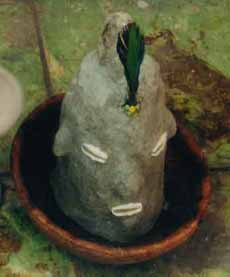Posted by Quixie at 8:48 AM
Read our previous post

In a post below, I hinted at how secret and mysterious the Mormon church seems to most Americans, who know very little about it beyond this "weird" (for lack of a better term) and secret aspect.
A kind of parallel comes to mind when I think of the Lucumí and Carabalí and Dahomey religious traditions (and the rest of the West-African Diaspora derivates).
For some time, particularly after the successful rebellion of Toussaint L'Ouverture in Haiti and the audacious but short-lived Nat Turner rebellion in Virginia, slaves were not permitted, under pains of unimaginable violence on their persons, to practice any of their traditional liturgical rites or to display the old symbols, so nervous and afraid of solidarity among slaves did the revolts make the white folks.
Now, as will happen when you suppress such things, the slave community came up with a surrogate system of worship, one that co-opted the existing Catholic symbols and used them to represent the same deities (Orishas) as before only now it "looked" just like acceptable Catholicism to the naked eye. To the slaveowner who happened to drop in at the slave quarters and notice a statue of Saint Barbara as the centerpiece of some makeshift altar, it looked like devotion to a Catholic saint—harmless enough. Little did he know that that same statue was being used as a synchretic representation of Shangó (the "warrior" in the Orisha pantheon). Secrecy was solemnly guarded by initiates, and with good reason.
Time passed and eventually slavery was abolished and any stigma that the liturgical tradition might have once held was removed and the secrecy was no longer necessary. But old habits die hard, and the careful defensive posturing which eschews inquiry into the tradition from the outside world remains as a reminder of its "subversive" origin.
This reminds me of the Mormon timidity I pointed to in the earlier post and I thought I would add this afterthought.
This is the kind of thing I see happening there: that is, a religious group is persecuted and retreats into a defensive posture and retains this posture after (and despite) the removal of the persecution it once endured.
It's fascinating.
Ó
.
No comments:
Post a Comment
Comments left anonymously may or may not be posted.